The Odyssey
Photography by Michella Bredahl
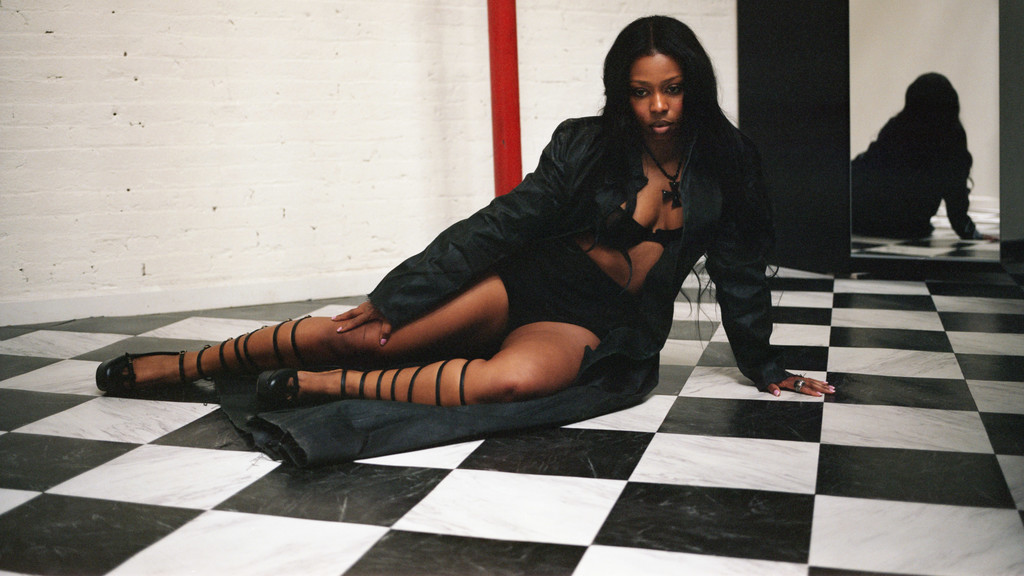
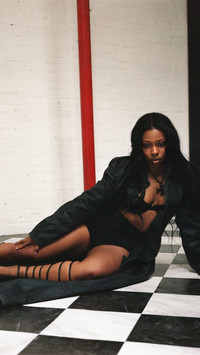
The Odyssey
Photography by Michella Bredahl
Subverting Renaissance styles like forced perspective and the altar triptych, Naudline Pierre paints a new vision of spiritual space—one that is fluid and responsive rather than delimited and disciplinary. Amidst swirls of color, rays of light, and leaping flames, Pierre’s alter-ego protagonist moves through a mystical universe. Characters and narratives abound in Pierre’s images, with evil and strife depicted alongside joy and tenderness. Oil paints take on the effect of pastels and flattened space makes room for layered personal iconography. Pierre’s work is roving and restless, resisting expectation even while returning to consistent themes. Like Pierre herself, the world she builds is multifaceted, free, ever-expanding: a higher plane of existence and a relationship to eschatology that might open new futures instead of predicting definitive endings.
Can you tell me about how you started out?
When I first started painting, it was for an MFA—and it was very traditional. An atelier-style program. We did anatomy for about six hours a day. It was a lot, but it worked out for me because I love the figure and I think being able to paint from my imagination wouldn’t have been possible without those fundamentals.
So you got a classical underpinning.
Yes. And then I broke it. In the second semester I had a residency at

That makes sense though, considering your dad was a pastor and you grew up around a certain spirituality. Whatever forged your unconscious seems to be working in a magical way.
It’s working now, but honestly it took a little bit for me to be okay with not letting my upbringing confine me—to use it and expand on it instead. I try not to focus on specifics because I hate feeling locked down or categorized. I’m interested in a fragmented existence. Taking pieces from all of these different things to create something that feels like a self, but a self that is always moving and growing and changing. I need freedom. I need to live inside multiplicity. It’s about escaping capture, really.
I understand that. I recently read “
Yes, for me, it’s about fantasy, and within that, you’re going to get all these subconscious political things crop up—because I can’t help but be a Black woman. I have to deal with a lot because of that, but it doesn’t mean that I have to be so literal in the way that I try to distill those experiences, right? The fact that my work imagines another place, a place where power is something that I have access to, is political. In so far as just doing whatever I want as a Black woman is political. But it’s not literal within the paintings.
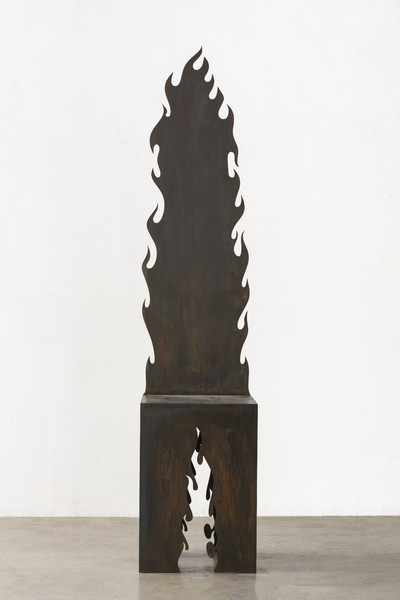
On a good day, I’m tapped in, and there’s a flow between me, the characters in the painting, and the material itself. When I don’t feel that, I sometimes have a conversation where I’m asking the painting to reveal itself to me. My process is sort of like a prayer, and there is a feeling of worship—not necessarily worshiping a person or divinity, but a set of feelings or a moment in time that I’ve captured, like a still from a film.
On a good day, I’m tapped in, and there’s a flow between me, the characters in the painting, and the material itself. When I don’t feel that, I sometimes have a conversation where I’m asking the painting to reveal itself to me. My process is sort of like a prayer, and there is a feeling of worship—not necessarily worshiping a person or divinity, but a set of feelings or a moment in time that I’ve captured, like a still from a film.
Exactly. That’s what I love about fantasy, it shows us places of un-reality.
I’m playing with that, certainly, alongside the idea of letting the paintings become their own spirituality. I grew up in an intensely religious household, and the end of the world, the apocalypse, was part of everyday language. I was told we didn’t have much time on this Earth, it was going to be over soon, which meant life was about preparing for another place. A place I couldn’t see, fathom, or understand. You can’t really shake the things that were given to you as a child, I realized, and so now, instead of fighting against it, I’m using those religious notions. I’m taking that iconography and mythological space and making it beneficial to me. Just as I use color, texture, and composition in my work, I now take forms, like angelic or seraphic beings, and make them my own. It’s about removing their original meaning and making them mine.
It makes me wonder, especially given your classical training, do you feel your work resonates with
Absolutely. On a good day, I’m tapped in, and there’s a flow between me, the characters in the painting, and the material itself. When I don’t feel that, I sometimes have a conversation where I’m asking the painting to reveal itself to me. My process is sort of like a prayer, and there is a feeling of worship—not necessarily worshiping a person or divinity, but a set of feelings or a moment in time that I’ve captured, like a still from a film. Love, loss, anger, lust—all of these are in the paintings because, while they’re not self-portraits, there’s a central alter-ego figure in these, and she and I are growing at a parallel pace. What she’s going through is going to affect me, what I’m going through is going to affect her, and we meet at the canvas. It’s a point of communication. It’s spiritual, in that sense, but that’s just one layer of the work. One of many.
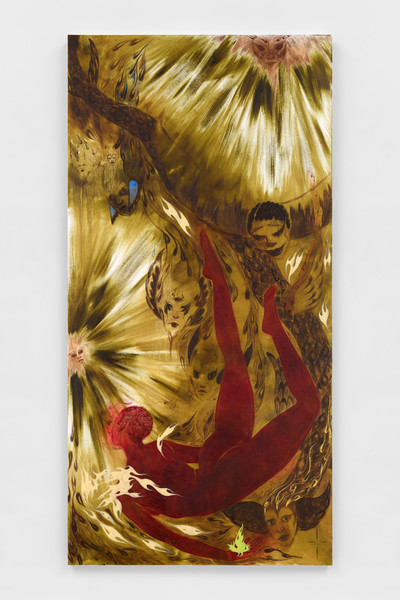

There’s clearly a multiplicity of influences and ideas at play–and that multiplicity is what creates your uniqueness.
I totally agree—multiplicity applies to my approach generally. When I started making work in school, I broke out of using traditional skin tones. I needed more freedom because I knew there were all these little categories that people were going to try to push me into. So from the very beginning, I’ve instinctively moved away from anything that might tie me down or box me in.
Which takes me to another question I had for you—I just read this book by Philip Guston,
Period. Exactly.
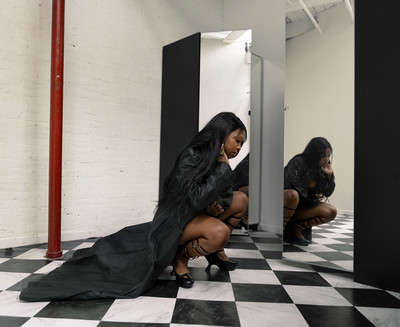
[laughs] Wow, shit, yes. Done—question over!
But actually, very high key, that’s exactly what it is. I paint what I want to see.
Exactly. But, so Guston loved
In the act of painting, I’m always searching. Honestly, in life and in work, I feel like I’m in a fog and I’m just looking. Looking for myself, for love, for meaning. But in terms of putting that inside of a frame, I never really feel the image is it. The image for me is more about what’s not seen, what’s happening outside of the canvas. Going back to the idea of treating it as a still in a film, in my mind something is moving and then the painting is just a snapshot of a single piece of that movement. It’s never really done, it’s one small part of a non-linear flow.
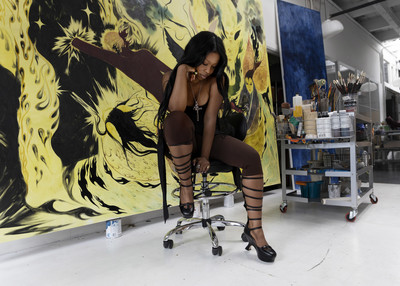
Do you feel that all your paintings are connected in a way then? That they’re all part of a massive film or odyssey, without a beginning or ending?
Absolutely. There’s no beginning and there’s no ending because I can’t place an order onto it. It’s about the search—the paintings are a beautiful byproduct, but I’m always thinking beyond that, to what’s possible next. It’s about the vastness of existence. To me that’s ultimate freedom.
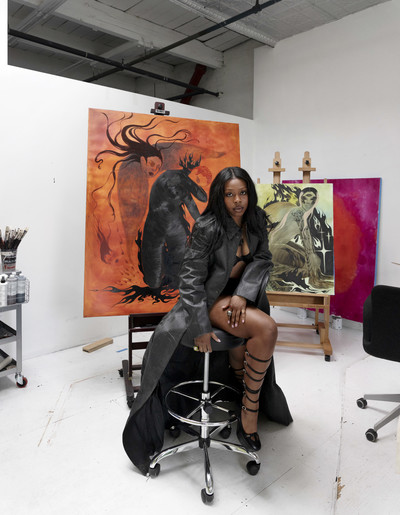
If Dubois posed a “double-consciousness,” defining it as the strange sense of two-ness, the split-self of the black person displaced in another land becoming “two souls, two thoughts, two un-reconciled strivings; two warring ideals in one dark body,” then, now, it is appropriate to suggest that double has multiplied. We live in a time where there’s cause for the advent of a triple, or quadruple, or perhaps best put, a multi-consciousness. The diasporic black experience is uniquely marked by a permeating sense of dichotomy, between the sense of blackness and the opposing realities and ideals of the society the black person is displaced in. What is of vital interest is the additional layers of consciousness that have arrived with the passage of time, for the children of the second, third or fourth generation, of whom there isn’t the imminent displacement from one to another, only the idea of another place, or the teachings and passings on through previous generations of ideals, myths, religion, and sensibilities. It is strange enough, that one is taught and raised in the African common belief of the unseen, and then lives in a secular West. But, the contemporary phenomenon of multi-consciousness isn’t limited to race or diasporic displacement alone, it is shared by most – we live between multiple realities: the Internet, the television, day-to-day life, the realities of the various ideologies and religions of the present era. Layers of reality that topple over one another, producing a mass state of confusion, and a subsequent search to remedy it. But, the black person, now, perhaps lies at the base of the flame, in an exaggerated chasm, facing the conflicting realities of the contemporary world, and dragging on in a perpetual state of non-belonging that ultimately produces this new, unique form of existence – a surreal existence, which in turn, has led to, in the case of a few chosen artists that represent this new sub-movement in art, a body of work that I want to call New Black Surrealism.